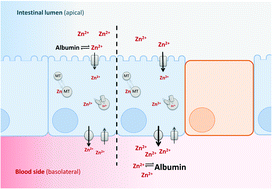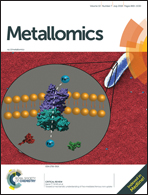The impact of apical and basolateral albumin on intestinal zinc resorption in the Caco-2/HT-29-MTX co-culture model†
Abstract
The molecular mechanisms of intestinal zinc resorption and its regulation are still topics of ongoing research. To this end, the application of suitable in vitro intestinal models, optimized with regard to their cellular composition and medium constituents, is of crucial importance. As one vital aspect, the impact of cell culture media or buffer compounds, respectively, on the speciation and cellular availability of zinc has to be considered when investigating zinc resorption. Thus, the present study aims to investigate the impact of serum, and in particular its main constituent serum albumin, on zinc uptake and toxicity in the intestinal cell line Caco-2. Furthermore, the impact of serum albumin on zinc resorption is analyzed using a co-culture of Caco-2 cells and the mucin-producing goblet cell line HT-29-MTX. Apically added albumin significantly impaired zinc uptake into enterocytes and buffered its cytotoxicity. Yet, undigested albumin does not occur in the intestinal lumen in vivo and impairment of zinc uptake was abrogated by digestion of albumin. Interestingly, zinc uptake, as well as gene expression studies of mt1a and selected intestinal zinc transporters after zinc incubation for 24 h, did not show significant differences between 0 and 10% serum. Importantly, the basolateral application of serum in a transport study significantly enhanced fractional apical zinc resorption, suggesting that the occurrence of a zinc acceptor in the plasma considerably affects intestinal zinc resorption. This study demonstrates that the apical and basolateral medium composition is crucial when investigating zinc, particularly its intestinal resorption, using in vitro cell culture.



 Please wait while we load your content...
Please wait while we load your content...